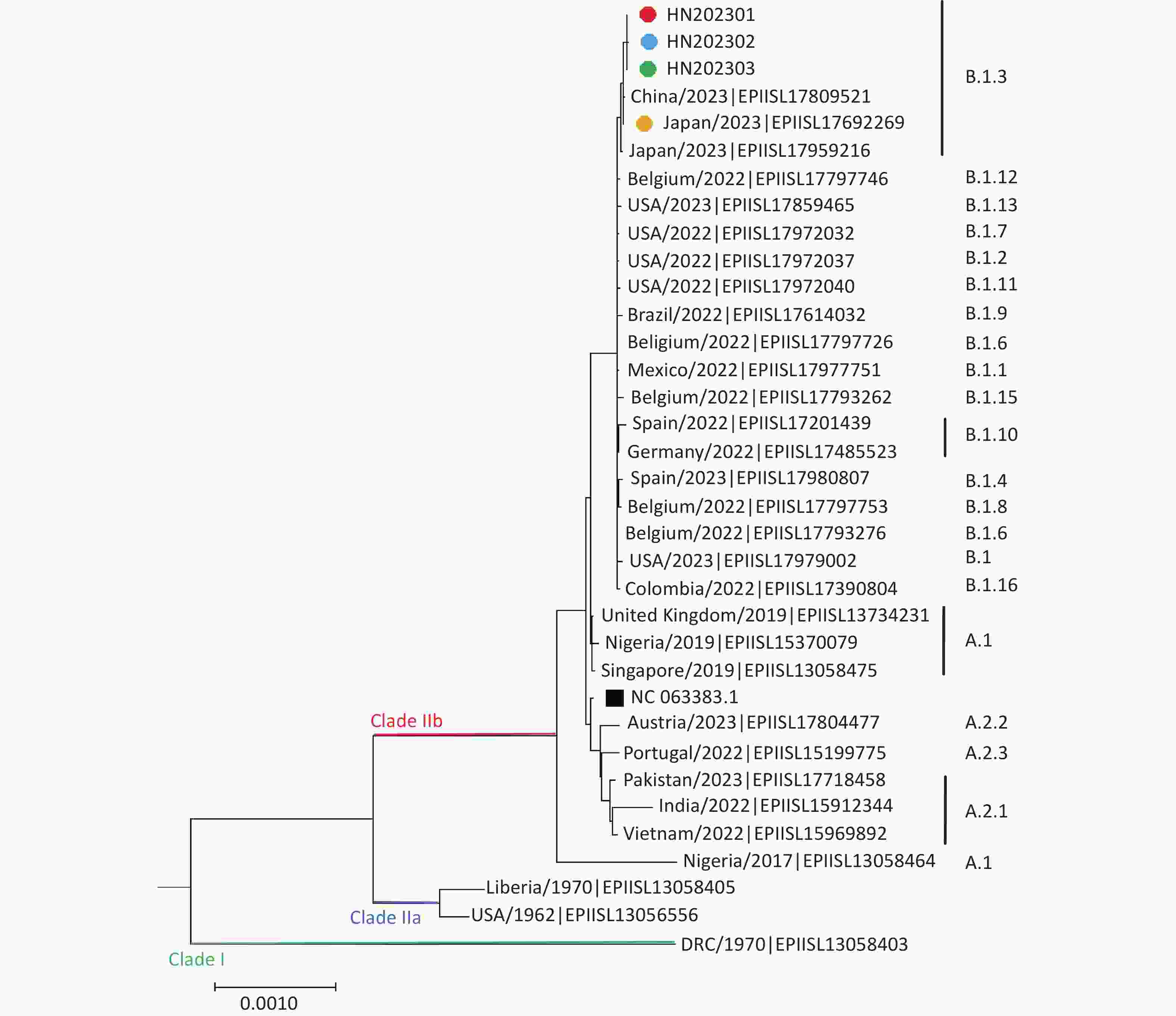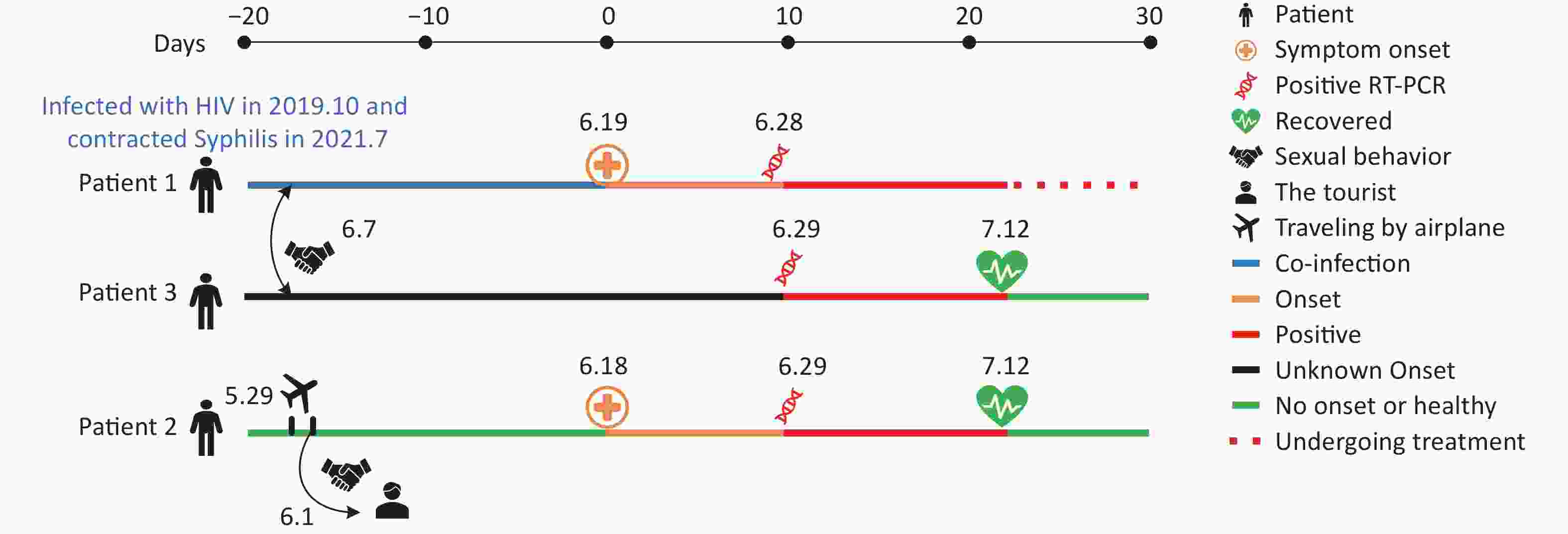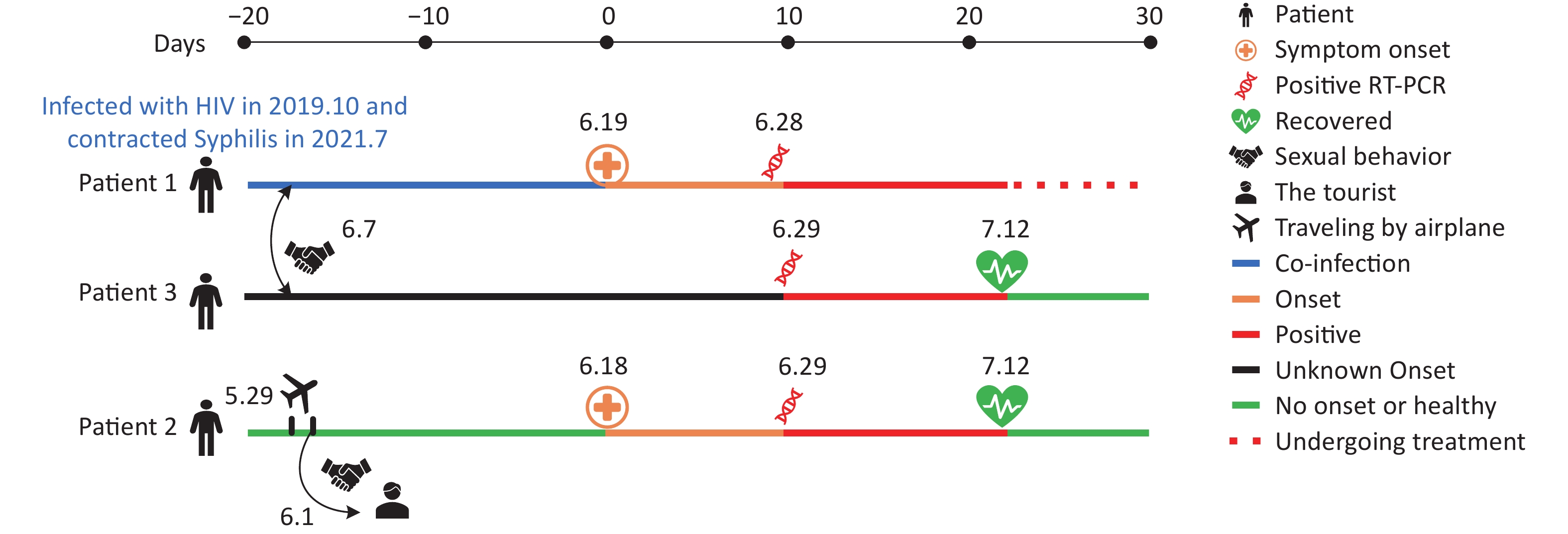-
Mpox virus (MPXV) belongs to the family Poxviridae, subfamily Chordopoxvirinae, and genus Orthopoxvirus, which also includes Variola virus (VARV), Cowpox virus (CPXV), and Vaccinia virus (VACV). Clinical symptoms of mpox are similar to smallpox but are relatively milder[1]. MPXV was first isolated from crab-eating monkeys in the tropical rainforests of Africa in 1958[2]. The first human case of MPXV infection was reported in the Congo in 1970[3]. Following the eradication of smallpox in 1977, mpox has emerged as one of the prominent viral members of the Poxviridae family, significantly impacting public health[4], mainly prevalent in Central and West Africa. Starting from May 2022, many countries including China outside of Africa have reported cases of human mpox virus infection[5], and as of July 9th, 2023, a total of 88,288 mpox cases have been recorded worldwide with 149 fatalities, indicating a severe epidemic situation.
On June 28, 2023, the samples of throat swabs and vesicle fluid from a suspected mpox virus infection case were sent to the Hunan Provincial Center for Disease Control and Prevention, and the MPXV was positive after being tested with real-time PCR (target gene: F3L), and On June 29, two additional cases of mpox were confirmed, making up the first mpox outbreak in Hunan province.
The clinical manifestations of the three cases also align with the main clinical features of mpox, including fever, rash, lymphadenopathy, and diarrhea[6]. Case 1 developed fever on June 19, followed by the appearance of rash in the perineum, which gradually spread to the back and limbs, furthermore, cough and lymphadenopathy were also present, and he has a history of HIV and syphilis infection. Case 2 developed fever and rash on June 18, with the rash spreading from the perianal area to the abdomen, limbs, head and face, in addition, chills, night sweats, and diarrhea were also present. Case 3 had an unknown date of onset and sought medical attention on the 28th, with fever and rash in the perianal and hand areas. After the confirmation of the three cases, they were isolated and treated at the Infectious Disease Hospital in Changsha. Case 2 and Case 3 met the discharge criteria and were discharged on July 12, while Case 1 is still under treatment (Table 1). In the clinical treatment of this mpox outbreak, the case with HIV and syphilis co-infection had more severe symptoms and a longer treatment duration compared to the other two cases without co-infection. It suggests that patients infected with HIV may be more sensitive to mpox virus, and further analysis of this case should be combined with its clinical immune characteristics.
Table 1. Basic information of the 3 cases of monkeypox in Hunan
Patient number Sex/age Clinical features Co-infection Onset date Recovery
statusMSM Contact outside
the provinceMarital status 1 Male/34 Fever, rash (in the perineal area, legs, arms, and back), cough, and swollen lymph nodes HIV, syphilis 6.19 Undergoing treatment Yes No Married 2 Male/34 Perianal rash (spreading to the abdomen, thighs, soles of the feet, neck, and facial area), chills, night sweats, and diarrhea No 6.18 Discharged on
July 12thYes Yes Unmarried 3 Male/22 Fever, perianal, and hand rash No Unknown Discharged on
July 12thYes No Unmarried Note. MSM, men who have sex with men. The epidemiological characteristics of three mpox cases were obtained through case investigation (Figure 1). All cases lived in Hunan province, and were men who have sex with men (MSM). Case 1 was a married e-commerce salesperson who had engaged in sexual activity with Case 3 on June 7 and had multiple sexual partners, and the sexual partners are currently under investigation. Case 1 did not leave Hunan in the month before the onset of symptoms and had no contact with symptomatic rodents or primates, and no similar symptoms were observed in family members or colleagues. Case 2 was unemployed, unmarried, and had no history of travel abroad. On May 29, he flew to Sanya and had sex with a male tourist from Inner Mongolia on June 1. He flew back on June 2 and had no close contact with others until the onset of symptoms on June 18. Case 2 had been living with his father, whose throat swab tested negative for mpox virus. Case 3 was unmarried and graduated from university on June 22. He had sex with Case 1 on June 7 and reported no sexual activity with anyone else in the past six months. The throat swabs of three roommates who lived in the same dormitory with Case 3 before graduation tested negative for mpox virus nucleic acid. The three cases of mpox reported were all local cases, and had engaged in male-male sexual activity within 21 days prior to the onset of symptoms, confirming the current trend of mpox virus transmission through sexual activity in the 20–50 age MSM group[5].
Mpox virus can be divided genetically into the Central African clade (Clade I) and the West African clade (Clade IIa and Clade IIb)[7]. The third-generation sequencing was conducted utilizing the Nanopore GridION sequencer to confirm the genotype of MPXV in this outbreak. The mpox virus genome NC_063383.1 was used as the reference sequence, the viral sequences of the three cases (HN202301, HN202302, HN202303) were aligned and analyzed with the Nextclade tool. Mpox sequences of different time nodes were downloaded from GISAID mpox database, and phylogenetic analysis was performed by mega11 (Figure 2). The results showed that the viruses of the three cases all belonged to mpox virus branch II (West African branch) B.1.3 subtype, with the closest evolutionary relationship to the Japanese sequence EPIISL17692269 (referred to as the Japanese sequence). There were 9 nucleotide differences between the sequence of Case 1 (HN202301) and the Japanese sequence: the Japanese sequence had 2 unique nucleotide mutation sites (G2591A, G57786A), and the HN202301 had 7 unique nucleotide mutation sites (C21062T, C60105T, T68759C, T75784C, G101241A, C132402T, G152866A). There were 11 nucleotide differences between the sequence of Case 2 (HN202302) and the Japanese sequence: the Japanese sequence had 2 unique nucleotide mutation sites (G2591A, G57786A), and the HN202302 had 9 unique nucleotide mutation sites (C21062T, C46789T, G51559A, C60105T, T68759C, T75784C, G92349A, G101241A, G152866A). There were 12 nucleotide differences between the sequence of Case 3 (HN202303) and the Japanese sequence: the Japanese sequence had 4 unique nucleotide mutation sites (G2591A, G57786A, G64297A, C64426T), and the HN202303 had 8 unique nucleotide mutation sites (G7087A, C21062T, C60105T, T68759C, T75784C, G101241A, G126671A, G152866A). In addition, the three sequences were closely related to each other. There were 5 nucleotide differences between the HN202303 and the HN202301, with Case 1 having 3 unique nucleotide mutation sites (G64297A, C64426T, C132402T) and Case 3 having 2 unique nucleotide mutation sites (G7087A, G126671A). There were 4 nucleotide differences between the HN202302 and the HN202301, with Case 1 having 1 unique nucleotide mutation site (C132402T) and Case 2 having 3 unique nucleotide mutation sites (C46789T, G51559A, G92349A). The three cases reported belong to the B.1.3 subtype within the West African clade[8,9], with some genetic mutations but a weak mutation rate and low pathogenicity[6], resulting in better prognosis for the patients. Although mpox cases currently reported worldwide are all from the West African clade[10], given the severity of the current epidemic situation, the spread of the Central African clade should be guard against.

Figure 2. Phylogenetic relationships of monkeypox virus strains from initial three MPXV infected patients in Hunan and reference strains from GISAID. Scale bar indicates number of base substitutions per site.
In conclusion, the transmission and spread of mpox in Hunan province pose a high risk among the MSM population, while the risk of spread in the broader society is relatively low. Focusing on high-risk communities and specific populations, and strengthening laboratory screening and public education on mpox for patients visiting sexually transmitted disease and dermatology clinics, are of great significance for diagnosis, treatment, monitoring, and epidemic control of mpox virus infection.
doi: 10.3967/bes2023.152
The Pathogenic Characteristics of the Initial Three Mpox Cases in Hunan Province, China
-
&These authors contributed equally to this work.
注释: -
Table 1. Basic information of the 3 cases of monkeypox in Hunan
Patient number Sex/age Clinical features Co-infection Onset date Recovery
statusMSM Contact outside
the provinceMarital status 1 Male/34 Fever, rash (in the perineal area, legs, arms, and back), cough, and swollen lymph nodes HIV, syphilis 6.19 Undergoing treatment Yes No Married 2 Male/34 Perianal rash (spreading to the abdomen, thighs, soles of the feet, neck, and facial area), chills, night sweats, and diarrhea No 6.18 Discharged on
July 12thYes Yes Unmarried 3 Male/22 Fever, perianal, and hand rash No Unknown Discharged on
July 12thYes No Unmarried Note. MSM, men who have sex with men. -
[1] Gessain A, Nakoune E, Yazdanpanah Y. Monkeypox. N Engl J Med, 2022; 387, 1783−93. doi: 10.1056/NEJMra2208860 [2] Alakunle E, Moens U, Nchinda G, et al. Monkeypox virus in nigeria: infection biology, epidemiology, and evolution. Viruses, 2020; 12, 1257. doi: 10.3390/v12111257 [3] Mitjà O, Ogoina D, Titanji BK, et al. Monkeypox. Lancet, 2023; 401, 60−74. doi: 10.1016/S0140-6736(22)02075-X [4] Tiecco G, Degli Antoni M, Storti S, et al. Monkeypox, a literature review: what is new and where does this concerning virus come from? Viruses, 2022; 14, 1894. [5] Thornhill JP, Barkati S, Walmsley S, et al. Monkeypox virus infection in humans across 16 countries - April-June 2022. N Engl J Med, 2022; 387, 679−91. doi: 10.1056/NEJMoa2207323 [6] Hatmal MM, Al-Hatamleh MAI, Olaimat AN, et al. Comprehensive literature review of monkeypox. Emerg Microbes Infect, 2022; 11, 2600−31. doi: 10.1080/22221751.2022.2132882 [7] Monkeypox: experts give virus variants new names. Neurosciences (Riyadh), 2022; 27, 284-86. [8] Luna N, Muñoz M, Bonilla-Aldana DK, et al. Monkeypox virus (MPXV) genomics: a mutational and phylogenomic analyses of B. 1 lineages. Travel Med Infect Dis, 2023; 52, 102551. doi: 10.1016/j.tmaid.2023.102551 [9] Dumonteil E, Herrera C, Sabino-Santos G. Monkeypox virus evolution before 2022 outbreak. Emerg Infect Dis, 2023; 29, 451−53. doi: 10.3201/eid2902.220962 [10] Luna N, Ramírez AL, Muñoz M, et al. Phylogenomic analysis of the monkeypox virus (MPXV) 2022 outbreak: emergence of a novel viral lineage? Travel Med Infect Dis, 2022; 49, 102402. -





 下载:
下载:




 Quick Links
Quick Links